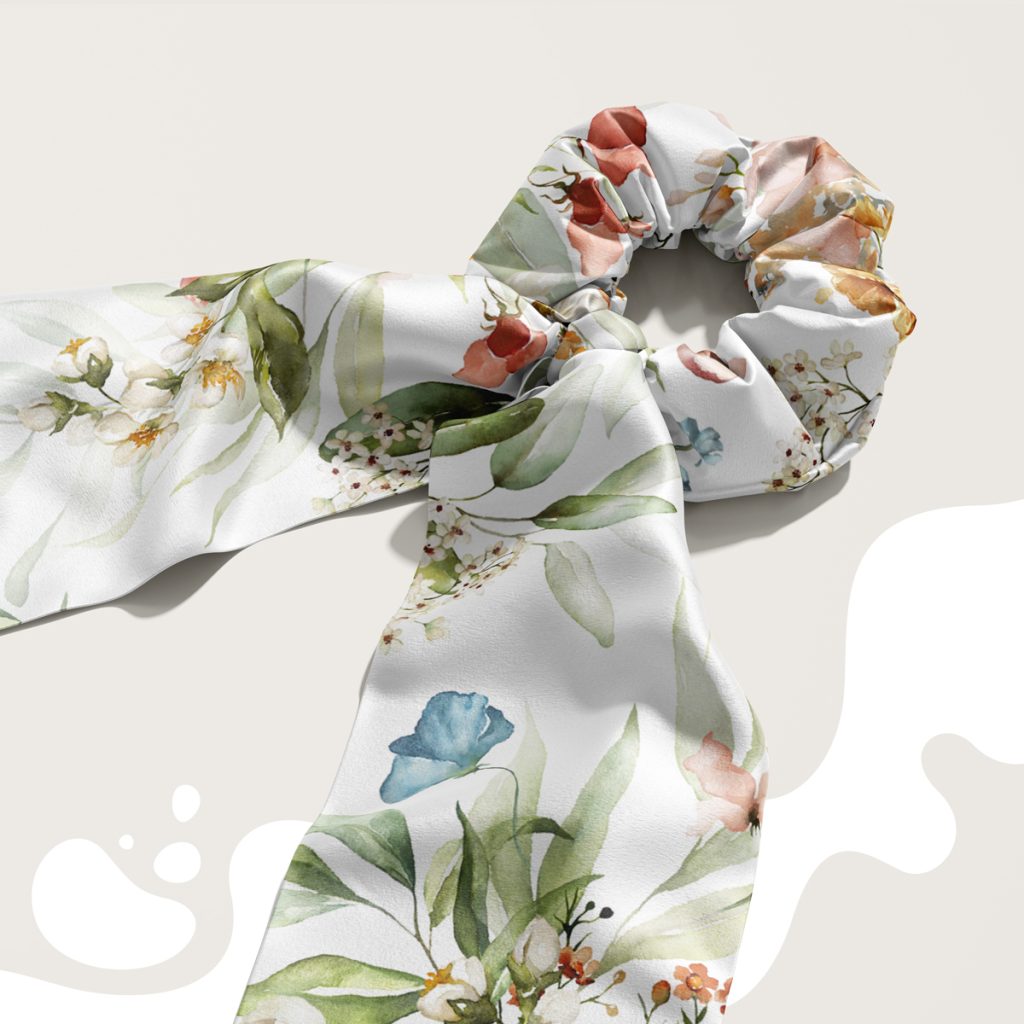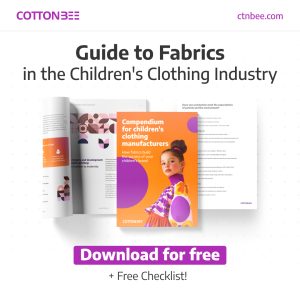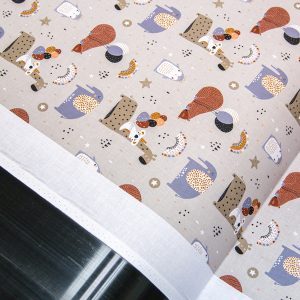Are you dreaming of personalised, unique hair elastics that are not only stylish but also functional? Wondering how to start your adventure in creating and selling this handicraft? Read on! Today, we bring you a full guide on how to sew hair elastics!
Table of Content
- Types of hair elastics – what can you sew?
- The tools you need to sew hair elastics yourself
- Hair elastic and a fabric – what qualities should it have?
- The best fabrics to sew hair elastics yourself
- Digital printing on hair elastics – yes or no?
- Where to sell hand sewn hair elastics?
- Sewing hair elastics – summary
Types of hair elastics – what can you sew?
Classic scrunchies
Classic scrunchies are one of the most popular hair accessories, known and appreciated for their functionality and aesthetics. They are made of a fine fabric that covers the elastic band. Scrunchies are gentle on the hair, which means they do not cause creases or damage to strands. They are ideal for everyday use, as they are easy to put on and take off without risking hair pulling or plucking.
Seamless elastics
Seamless elastics are a modern solution for those who value comfort and softness. They are made of a stretchy fabric that has no seams, making them even more hair-friendly. They do not cause friction, which minimises the risk of hair breakage and plucking during use. Seamless elastics are perfect for everyday wear, providing comfortable all-day wear. They can be used for both loose and more complicated hairstyles, providing stability and an aesthetically pleasing look.
Terry elastics
Terry cloth erasers are a classic choice, particularly popular with those who play sports or are often in humid environments. Covered in soft terry, they are extremely gentle on hair, making them ideal for everyday use. Their soft texture prevents hair tangling while providing a firm hold. The terry erasers are also durable and moisture-resistant, making them perfect for wearing in the bath, at the pool or during intense workouts.
Elastics with decorations
Decorative elastics are unique accessories that can add character to any hairstyle. They are made from a variety of materials and are often decorated with accessories such as bows, beads, flowers or glitter. They are ideal for special occasions such as weddings, parties or social gatherings where appearance is of particular importance.

The tools you need to sew hair elastics yourself
Sewing hair elastics is an activity that doesn’t require a lot of money or advanced equipment. You can get started with this craft with basic tools and accessories at hand. Here’s what you’ll need:
- Needles: an essential tool for hand sewing. Choose needles of the right thickness for the type of fabric you want to sew elastic bands with.
- Pins: Essential for temporarily fixing the fabric while sewing. They help to accurately fold and hold the fabric in place, making it easier to complete your project accurately.
- Scissors: Good quality scissors are essential. Choose tailor’s scissors that will cut fabric accurately and evenly. Remember to only use them on fabrics so they don’t dull too quickly.
- Threads: Choose threads that match the colour of the fabrics you intend to sew elastic bands with. Opt for high quality to ensure the durability of your handicraft.
- Elastic: An elastic band is a key component of any hair elastic. You can choose from different widths and elasticities, depending on your preference and needs.
- Fabric marker: Makes it easier to mark cut lines and seams on fabric. It is indispensable when planning and cutting fabric with precision.
While these basic tools are sufficient to get you started, it is worth considering purchasing a sewing machine at a later stage. A machine will speed up the production process considerably, allowing you to create more rubber bands faster. However, it is not a necessary expense in the beginning. It is better to focus on honing your skills and building your customer base.
Hair elastic and a fabric – what qualities should it have?
Choosing the right fabric for hair elastics is crucial to ensure their comfort and durability. The ideal material should meet a few basic characteristics:
- Gentleness for hair: The material should be soft and gentle so that it does not cause tangles, static, creases or damage to the hair.
- Durability: The hair elastic must be made of a material that can withstand stretching and daily use.
- Resistance to damage: The material should be durable, resistant to moisture and mechanical damage so that the elastic can last a long time without losing quality.
The best fabrics to sew hair elastics yourself
Cotton is one of the best fabrics for hair elastics. It is natural, gentle on the hair and scalp and does not cause allergies. Cotton elastic bands are durable and stand up well to water contact, making them ideal for everyday use.
Loopback Jersey is a soft, pleasant to the touch and flexible material. It is perfect for hair elastics as it is durable and resistant to damage. This fabric holds its shape well and is easy to work with, making it easy to sew.
Velour is a fabric with a beautiful sheen that gives elastics an elegant look. It is soft, flexible and crush-resistant, which makes elastics made of velour not only stylish but also durable. Thanks to its texture, velour is ideal for elastics for both everyday use and special occasions, adding a unique shine to your hair.
Silk is one of the most desirable fabrics for hair elastics. It is extremely soft, smooth and fine, which prevents hair breakage and tangling. Silk elastics are ideal for everyday and overnight wear, as they minimise friction and do not cause damage to the hair. Silk is also very strong and flexible for long-lasting use.
Satin is a fabric with a smooth and slippery surface that is ideal for hair elastics. It reduces friction, which protects the hair from damage and electrification. Satin elastics are ideal for overnight wear as they minimise pressure on the hair and scalp.
Digital printing on hair elastics – yes or no?
Digital printing on hair elastics can be a great choice, especially if you want to offer models with a variety of designs. This technique allows for extremely precise and durable designs, giving you unlimited personalisation possibilities. For elastics made from natural materials such as cotton or linen, digital printing is a particularly durable and attractive option. Depending on the rubber band material, different digital printing methods can be used, such as sublimation, pigment or acid printing.
Sublimation printing – ideal for polyester
Sublimation printing is a digital printing technique ideal for polyester fabrics. In this process, sublimation inks are heated to a high temperature and then transferred to the fabric in the form of a gas that directly penetrates the fabric fibres. This produces highly durable and vivid colours that do not fade or wash out when washed. Sublimation printing is ideal for creating polyester hair elastics, offering a wide range of designs and colour intensity.
Pigment printing – best for cotton
Pigment printing is a digital printing method that works well on cotton fabrics. Pigments are applied to the surface of the fabric and then fixed with heat. Pigment printing ensures high quality and long-lasting designs that are resistant to washing and fading. Hair elastics made from pigment-printed cotton are characterised by the clarity of the colours and the precision of the details.
Acid printing – suitable for silk
Acid printing is a digital printing technique that is ideal for silk fabrics. This process uses acid dyes, which are applied to the fabric and fixed in an acid bath. Acid printing produces deep, saturated colours.
Where to sell hand-sewn hair elastics?
Selling hand-sewn hair elastics can be a rewarding and profitable business. In order to reach a wide range of potential customers and effectively promote your products, it is worth using a variety of sales and promotion channels.
Social Media
Promoting your hair elastics on social media, such as Instagram, Facebook and Pinterest, is a great way to reach a wide audience. Instagram allows you to create compelling photos and testimonials that showcase your products and the process of making them. Use popular hashtags related to crafts, fashion and beauty to increase the reach of your posts. Facebook offers the opportunity to join groups dedicated to crafts, where you can showcase your products and share your experiences with other crafters. Create a page for your brand where you regularly post new rubber bands, promotions and event coverage. Pinterest is a platform where users look for inspiration, so create boards with eye-catching photos of your rubber bands, fashion inspiration and hair styling tips.
Etsy and Ebay
Etsy is one of the most popular platforms for crafters to sell unique, handmade products around the world. Set up a shop on Etsy, add professional photos of your hair elastics and detailed product descriptions. Remember to properly optimise your keywords so that your products are more easily found by customers. Ebay, can also be a good platform to sell your hair elastics. Create an account, add products and take care of positive feedback from customers.

Handicraft fairs and festivals
Attending local craft fairs and festivals is a great way to connect directly with your customers. Not only can you sell your hair elastics there, but you can also learn about the tastes and needs of your audience. Prepare an attractive stand that will attract the attention of visitors. Take care of the aesthetics of the presentation of your products, as well as business cards and promotional materials that customers can take away with them.
Your own website
Investing in your own website is a great way to build your brand and increase sales. The website should include a product gallery, an online shop, brand information and a blog where you share tips and inspiration.
Sewing hair elastics – a summary
Making your own hair elastics is not only about the satisfaction of creating, but also about the chance to create unique, personalised products. Keep in mind the right materials, tools and sales opportunities to turn your hobby into a market success. Get started today and discover the world of hand-sewn hair accessories!





